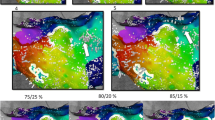Abstract
Background
High-density automated mapping of complex atrial tachycardias (ATs) requires accurate assessment of activation maps. A new local activation display module (HD coloring, Biosense Webster®) provides higher map resolution, a better delineation of potential block reducing color interpolation, and a new propagation display. We evaluated the accuracy of a dedicated local activation display compared with standard algorithm.
Methods
High-density maps from 10 AT were collected with a multipolar catheter and were displayed with standard activation or HD coloring. Six expert operators retrospectively analyzed activation maps and were asked to define (1) the tachycardia mechanism, (2) ablation target, and (3) level of difficulty to interpret those maps.
Results
Using HD coloring, operators were able to reach a correct diagnosis in 93% vs. 63%, p < 0.05 compared to standard activation maps. Time to diagnosis was shorter 1.9 ± 1.0 min vs. 3.9 ± 2.1 min, p < 0.05. Confidence level would have allowed ablation without necessity for entrainment maneuvers in 87% vs. 53%, p < 0.05. Operators would have needed to remap or proceed with multiple entrainments in 3% vs. 13% of cases, p < 0.05. Finally, ablation strategy was more accurately identified in 97% vs. 67%, p < 0.05.
Conclusion
Activation mapping with the new HD coloring module allowed a more accurate, reliable, and faster interpretation of complex ATs mechanisms compared to standard activation maps.


Similar content being viewed by others
Data availability
Dataset is available on request.
References
Durrer D, Roos JP. Epicardial excitation of the ventricles in a patient with wolff-Parkinson-White syndrome (type B). Circulation. 1967;35:15–21.
Kottkamp H, Hindricks G, Breithardt G, Borggrefe M. Three-dimensional electromagnetic catheter technology: electroanatomical mapping of the right atrium and ablation of ectopic atrial tachycardia. J Cardiovasc Electrophysiol. 1997;8:1332–7.
Shah DC, Jaïs P, Haïssaguerre M, Chouairi S, Takahashi A, Hocini M, et al. Three-dimensional mapping of the common atrial flutter circuit in the right atrium. Circulation. 1997;96:3904–12.
Takigawa M, Derval N, Frontera A, Martin R, Yamashita S, Cheniti G, et al. Revisiting anatomic macroreentrant tachycardia after atrial fibrillation ablation using ultrahigh-resolution mapping: implications for ablation. Heart Rhythm. 2018;15:326–33.
Scherr D, Khairy P, Miyazaki S, Aurillac-Lavignolle V, Pascale P, Wilton SB, et al. Five-Year Outcome of Catheter Ablation of Persistent Atrial Fibrillation Using Termination of Atrial Fibrillation as a Procedural Endpoint. Circ-Arrhythmia Elec 205;8:18–24.
Frontera A, Mahajan R, Dallet C, Vlachos K, Kitamura T, Cheniti G, et al. Characterizing localised reentry with high resolution mapping: evidence for multiple slow conducting isthmuses within the circuit. Heart Rhythm. 2018 [cited 2018 Dec 8];0. Available from: https://www.heartrhythmjournal.com/article/S1547-5271(18)31172-X/abstract.
Williams SE, Harrison JL, Chubb H, Whitaker J, Kiedrowicz R, Rinaldi CA, et al. Local activation time sampling density for atrial tachycardia contact mapping: how much is enough? Europace. 2018;20:e11–20.
Olshansky B, Okumura K, Henthorn RW, Waldo AL. Characterization of double potentials in human atrial flutter: studies during transient entrainment. J Am Coll Cardiol. 1990;15:833–41.
Tada H, Oral H, Sticherling C, Chough SP, Baker RL, Wasmer K, et al. Double potentials along the ablation line as a guide to radiofrequency ablation of typical atrial flutter. J Am Coll Cardiol. 2001;38:750–5.
Morgan JM, Haywood G, Schirdewan A, Brugada P, Geelen P, Meyerfeldt U, et al. “Double” potentials define linear lesion conduction block using a novel mapping/linear lesion ablation catheter. J Cardiovasc Electrophysiol. 2003;14:236–42.
Winkle RA, Moskovitz R, Mead RH, Engel G, Kong MH, Fleming W, et al. Ablation of atypical atrial flutters using ultra high density-activation sequence mapping. J Interv Card Electrophysiol. 2017;48:177–84.
Coffey JO, d’Avila A, Dukkipati S, Danik SB, Gangireddy SR, Koruth JS, et al. Catheter ablation of scar-related atypical atrial flutter. Europace. 2013;15:414–9.
Latcu DG, Squara F, Massaad Y, Bun S-S, Saoudi N, Marchlinski FE. Electroanatomic characteristics of the mitral isthmus associated with successful mitral isthmus ablation. Europace. 2016;18:274–80.
Acknowledgements
The authors would like to thank Miss Susana Marcelino for her technical support.
Author information
Authors and Affiliations
Corresponding author
Ethics declarations
Conflict of interest
Vincent Roger is an employee of Biosense Webster, Inc. The remaining authors declare that they have no conflict of interest.
Additional information
Publisher’s note
Springer Nature remains neutral with regard to jurisdictional claims in published maps and institutional affiliations.
Electronic supplementary material
ESM 1
(DOCX 9067 kb)
Video 1
3D activation map of a left atrium without the stdLAT module (left panel), and with the HDc module feature (right panel). The stdLAT activation displays an anterior focal pseudo-reentry. HDc module identifies two area of conduction block and delineates an anterior practical isthmus (AVI 17852 kb)
Video 2
(AVI 17184 kb)
Rights and permissions
About this article
Cite this article
Massoullié, G., Moubarak, G., Thomas, O. et al. Initial multicenter experience with a new high-density coloring module: impact for complex atrial arrhythmias interpretation. J Interv Card Electrophysiol 60, 313–319 (2021). https://doi.org/10.1007/s10840-020-00802-1
Received:
Accepted:
Published:
Issue Date:
DOI: https://doi.org/10.1007/s10840-020-00802-1




